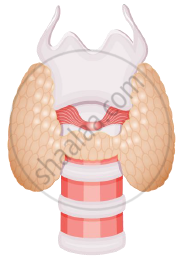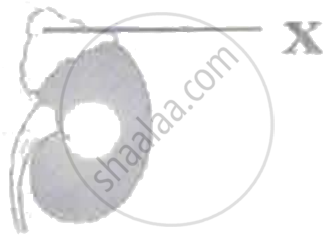Advertisements
Advertisements
प्रश्न
Give the exact location of the Adrenal gland
उत्तर १
Adrenal gland – Located at the top of each kidney as a cap-like structure
उत्तर २
Adrenal glands are like caps, above the kidneys (ad-near; renal-kidney). Each adrenal gland has two parts:
- A central medulla and
- A peripheral cortex
APPEARS IN
संबंधित प्रश्न
The diagram given below represents the location and structure of an endocrine gland. Study the same and answer the questions that follow

(i) Name the endocrine gland shown in the diagram.
(ii) Name the secretion of the gland which regulates basal metabolism.
(iii) Name the mineral element required for the synthesis of the above mentioned hormone.
(iv) Name the disease caused due to undersecretion of the above mentioned hormone in children.
(v) Name the disease caused due to hypersecretion of the above mentioned hormone.
fill in the blanks with suitable functions: Thyroid gland and _________
Differentiate between the following pairs on the basis of what is indicated in the brackets.
Testosterone and Oestrogen [organ which secrets]
If you stand to make your maiden speech before a large audience, your mouth dries up and heart rate increases. What brings about these changes?
Complete the following table by filling in the blanks numbered 1 to 7.
| Gland | Hormone secreted | Effect on body |
| (1) ______ | (2) ______ | Regulates basal metabolism |
| Pancreas ("beta" cells) | (3) ______ | Controls blood sugar |
| (4) ______ | (5) ______ | Increases heart beat |
| (6) ______ | Thyroid stimulating hormone | (7) ______ |
Adrenaline is also known as emergency hormone.
Short answer question
Explain how the adrenal medulla and sympathetic nervous system function as a closely integrated system.
Which gland is represented by 'X' in the given diagram?

Give an account of secretion of various parts of Adrenal cortex.
Match the terms given in column A with those in column B.
| Column A | Column B | ||
| (a) | Adrenaline | (i) | Hypoglycemia |
| (b) | Adrenal virilism | (ii) | Hyperglycemia |
| (c) | Addison's disease | (iii) | Mental retardation |
| (d) | Acromegaly | (iv) | Eyes are protruded |
| (e) | Cushing's syndrome | (v) | Excessive growth of bones in face |
| (vi) | Emergency hormone | ||
| (vii) | Masculine characters |
